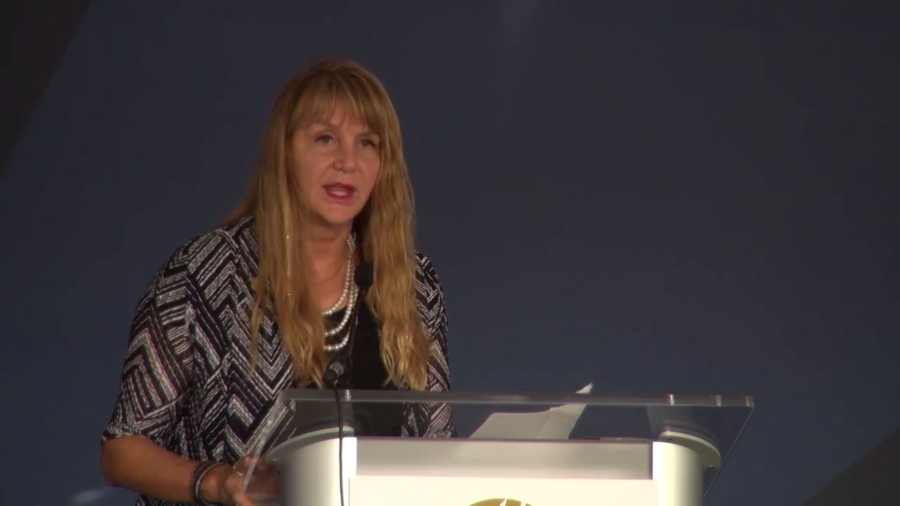Yvonne Marie Andrés: So, thank you to the Internet Society for this wonderful honor. I accept this recognition on behalf of all of my global collaborators, some of who are in the room tonight.
I started my career as a teacher, working with very low-achieving students, many coming from troubled families with drug, gang, and prison connections. But I had a life-changing moment in 1984 that finally got my students excited about learning. Apple launched a program called Kids Can’t Wait and gave every school in California a computer. Unfortunately the computer did not come with software. That was when Al Rogers, another San Diego teacher, and I teamed up to create a free word processing program that we called Free Educational Writer, or FrEdWriter.
Next came FrEdMail, which stood for Free Educational Electronic Mail. FrEdMail ran on an Apple IIe and used a store-and-forward protocol. That meant that students would write during class time, save their work on a floppy disk, and in the middle of the night when no one was using the phone line at the school and cost was the cheapest, FrEdMail would forward their writing to the next location. It sometimes took several weeks to get from one place to the next.
Everyone who heard about FrEdMail wanted to be part of the network, and it rapidly grew throughout the US and to other countries. There was an Aussie FrEd, a New Guinea FrEd, and I remember a colleague from Argentina who managed to get a Spanish version of FrEd into his country by hiding the installation disk under his shirt.
Then in 1991, thousands of FrEdMail mail users gained access to the NSFNET via new gateways at Merit in Michigan and SURFnet in San Diego. Thank you, Susan! Through the FrEdMail/NSF gateway, educators worldwide were able to share classroom experiences and connect students with scientists, business leaders, and explorers. At its peak, FrEdMail was used by 12,000 schools and had 350 nodes around the globe.
When the World Wide Web became available to the public in 1993, we launched our first web site called the Global Schoolhouse. That was the year we teamed up with Cisco Systems, Network Solutions, and MCI to facilitate an international CyberFair, which is an online world’s fair where youth create virtual exhibits about their local community. More than five million students from 105 countries have contributed. Hi, Tracy, wherever you are. She was involved. You’ll you’ll meet her later. This year we’re celebrating our twenty-second year running CyberFair and I would love to see projects from every one of your countries in this room.
One of my proudest moments came in 1994 when I received a National Science Foundation grant to introduce Internet-based desktop video conferencing called CU-SeeMe to K‑12 education. Working with Cornell University, we used CU-SeeMe to engage students with many notables, including former Internet Hall of Fame inductees, Vice President Al Gore, and Vint Cerf. We even used CU-SeeMe to launch the first ever television broadcast live over the Internet with World News Now. Thank you, Victor! Spoiler alert, I predicted that eventually we would be using the Internet to share news and learn together.
For me the Internet has always been about encouraging collaborations and people connections. For ten years I ran a program for high school students supported by the state department called Doors to Diplomacy. And after 9/11 I was invited to the White House to meet with President George Bush to create Friendship Through Education, a program aimed at using the Internet to increase cultural understanding.
Fast forward to today. GlobalSchoolNet has grown to 150,000 registered members from 194 countries. I am always looking for new opportunities to use the Internet in innovative ways that will improve the quality of life for all of Earth’s inhabitants. I currently coorganize the Global Forest Link project, which connects youth and scientists around the world to collaboratively analyze forest health, and last year GlobalSchoolNet joined forces with The Lavender Effect to organize the LGBT History Student Filmmaker Competition to encourage youth to produce digital stories that celebrate significant LGBTQ luminaries, landmarks, and contributions to society.
While I’m honored and humbled by the Internet Hall of Fame recognition, my greatest hope is that there are individuals and businesses listening today, or tomorrow, or next week, who will step up to offer support for the work that we do at GlobalSchoolNet. Thank you.
